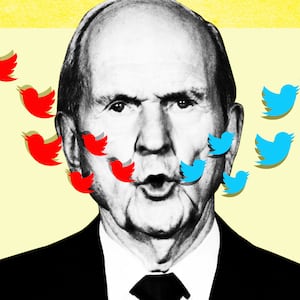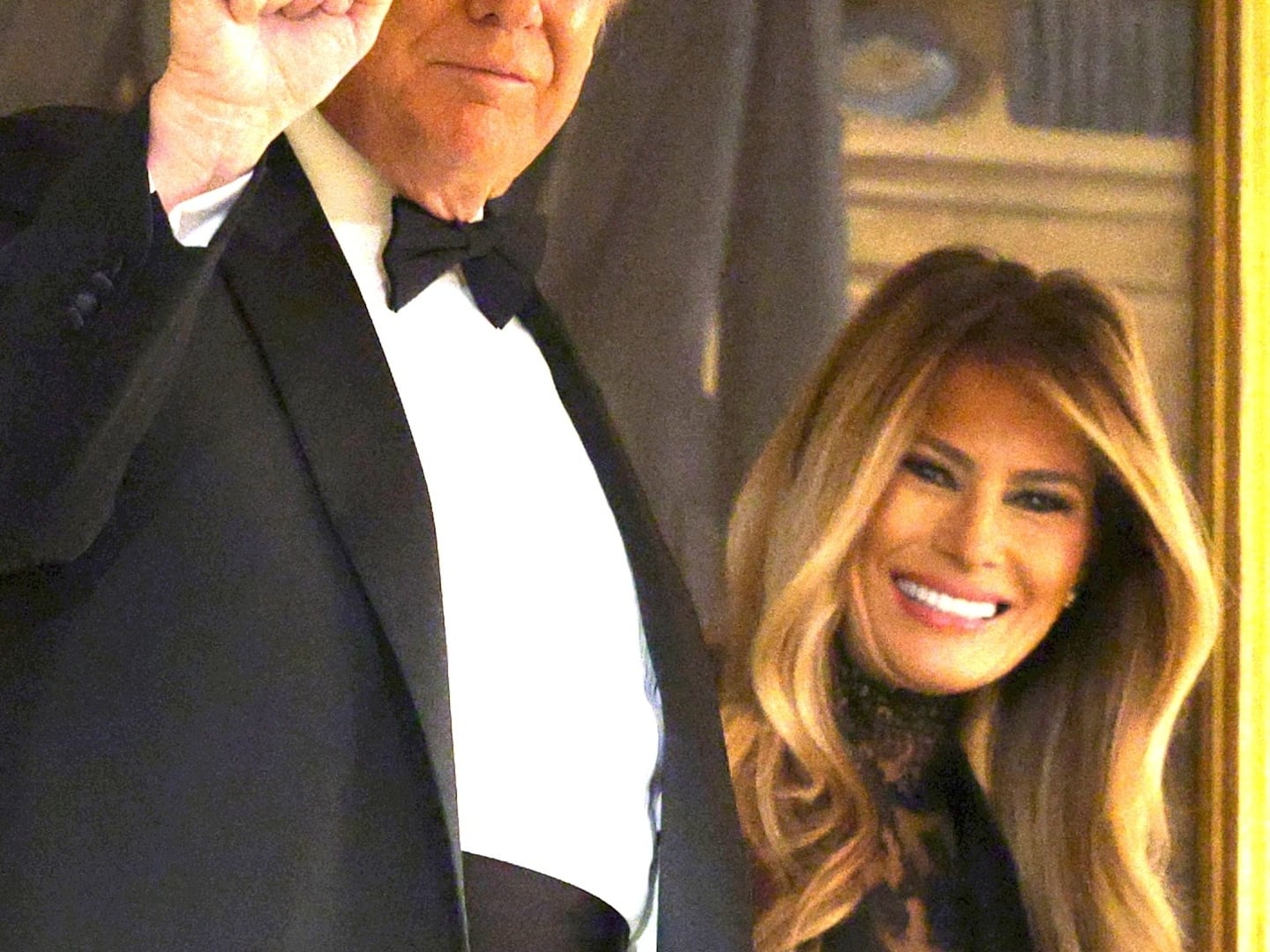In early January, a post appeared on the Twitter account @MormonQueerconf, a page devoted to anonymous confessions from LGBTQ members of the Mormon Church, about a new hashtag circulating in LDS Twitter: #DezNat. “I am ABSOLUTELY TERRIFIED of #deznat,” the post read. “I feel like it’s only one meltdown away from being the one who ends up killing someone like me.”
The comment came from Allison Wyles (not her real last name), a 25-year-old trans woman, a devoted member of the Church of Jesus Christ of Latter-day Saints, and a relatively new Twitter user. Wyles first made a Twitter account back in November, at the recommendation of her brother. Being trans and Mormon, Wyles told The Daily Beast, is often difficult, not just because of harassment from other members, but because the church’s stance on trans-identity is unclear. The Latter-day Saints have a defined position on homosexuality (they believe acting on same-sex desire is a sin), but little to no official doctrine on being transgender. “You’re sort of in limbo,” Wyles said.
Wyles’ brother recommended she join Twitter, in part to help her find more trans church members, and other people asking similar questions about the intersection of faith and gender. So she joined, and found exactly that. She also found #DezNat.
#DezNat stands for “Deseret Nation.” It’s a loose, extremely controversial affiliation of online Mormons, which has divided the LDS Twittersphere in the past five months, drawing praise from conservative church members, and concerned, even fearful, criticism from progressives.
Several conservatives who spoke to The Daily Beast claimed that the hashtag is apolitical, nothing more than a way for church members to aggregate doctrinal commentary on Twitter. “It’s not ‘nationalism,’” said Dustin Turner, a church member and former Ted Cruz staffer who uses the hashtag. “Have you ever seen Red Sox Nation? It’s got the same connotation.” Another #DezNat proponent, a 28-year-old Washington State Fish & Wildlife official named Brett Cain said that he was initially concerned by the tag. “Nationalism doesn’t sound too good,” Cain said. “But it was explained to be a Deseret Nation—not in terms of country or borders—but a group of people with common culture and that culture is The Church of Jesus Christ of Latter-day Saints.”
Still, others say it represents the most militant stream of Mormonism—a group of ultra-conservatives who often promote bigotry and violence against people of color, LGBTQ people, sex workers, non-Mormons, and former Mormons, or “apostates.” Steve Evans, a contributor to the progressive Mormon blog By Common Consent, told The Daily Beast that the group “varies from person to person… but sometimes it is more in the vein of nationalism. That is, it’s intended to designate a different (or higher) set of beliefs, a purer form of the religion, a higher level of devotion. It’s a shorthand for a very conservative subgroup of church members.”
Another Twitter user, a former Mormon who posts under the handle @McconneyMichael and goes by “Brother Mike,” echoed Evans’ concerns. He conducted an informal investigation into the group after finding himself on the receiving end of #DezNat harassment. “They basically just said that it was about very faithful—the word they used was ‘heterodox’—Latter-day Saints that were trying to prepare the world politically, socially, economically, for the second coming of Jesus,” Mike (not his real name) said. “They were trying to prepare for a theocracy.”
“I mean, at first it sounded like ‘Nazi’—#Deznat,” he added. “It sounded a little extreme to me right away.”
ORIGINS
The tag first appeared on Twitter in August of 2018 from the user @JPBellum, a self-described “violent agriculturalist” interested in “the Kingdom of God or nothing,” according to his Twitter bio. The user, who posts under the display name John Paul Bellum, published the inaugural tweet on August 6: “Is what you are doing today helping to building Deseret tomorrow? #DezNat,” he wrote.
By “Deseret,” Bellum was referring to a common term in Mormon lore meaning “bee hive,” which took on special significance when Brigham Young, the church’s second prophet, proposed it as the original name for a larger version of the state of Utah. Though Young’s proposal was rejected, the word is still in widespread use to connote a symbol of the predominantly Mormon state (the second-largest newspaper in Utah, for example, is called the Deseret News). But Bellum meant it much more literally, as he clarified in subsequent tweets: “#DezNat or Deseret Nation is basically the recognition that faithful members are a unique people and should be united spiritually, morally, economically, and politically behind Christ, the prophet, and the church,” one tweet read. “If all govt were gone tomorrow the church would fill that role.”
In the days after he first birthed the hashtag, Bellum tweeted out a series of quotes from high-ranking Mormon officials, some broad-sweeping but many which articulated positions on major political issues within the LDS community, like same-sex marriage, ordaining women in the priesthood, immigration, and secular government.
“Progressive Mormons [sic] insistence the the [sic] church wasn’t completely restored till blacks got the priesthood is now being leveraged to claim things like female priesthood and same sex marriage,” Bellum wrote, referring to the fact that black Mormons were barred from being ordained in the church until 1978.
In other tweets, Bellum echoed common conservative sentiments, like insisting immigrants speak English, and preaching abstinence for women.
By August 17, the tag had spread beyond Bellum to other users, many of whom espoused similar political stances and associated #DezNat with “Deseret Nationalism.”
In less than a month, the hashtag was getting regular use among a small group of Mormons, with usernames like @MilitantMormon, @MorMonger, @LatterDayOK, @DeseretDagger, @DeepStateDeseret, @AntiCommieSoc, and @BrighamGroyper, pairing the first name of Brigham Young with ‘Groyper,’ a smirking green animation, common among ultra-right-wing groups, which Slate’s Aaron May called “the fatter, more racist Pepe the Frog.”
By December, the tag had become so widespread that it attracted the attention of news outlets, prompting one member of the community to write an article on Medium, a text he claimed was “not a manifesto, because #DezNat does not need one.” The non-manifesto declared, among other things, that the tag was not “political, racial, national, or sexual.” But it also affirmed support for “The Family: A Proclamation to the World”—the 1995 text where Mormon leaders outlined their stance on homosexuality and gay marriage (which the church later used politically to petition state courts to ban gay marriage).
COMMON THEMES
According to the non-manifesto, #DezNat is not a movement so much as a hashtag used by LDS members who are “unapologetic about [their] belief” in the LDS president, who “anxiously seek to submit [their] wills to that of the Lord,” and who do not “worship at the altars of money, physical pleasure, diversity, or equality.” Still, most #DezNat posts return to a few common topics and terms.
Q15
Many #DezNat proponents cite the term “Q15” in their Twitter bios. The acronym is not an overtly QAnon-related abbreviation (though it “depends on the context,” as one source put it). Instead, the term stands for the leadership of the Mormon church: the “Quorum of the 12 Apostles” (Q12), and the three members of the “First Presidency” (FP), which comprises the president and his two counselors. There are “lots of acronyms” in Mormonism, Brother Mike told The Daily Beast, to the point where it can get confusing. (Case in point, he explained: “Q15 = FP + Q12.”)
Progmos, Exmos, Antimos & Apostates
Progmo stands for “Progressive Mormon,” exmo stands for “Ex-Mormon,” antimo stands for “Anti-Mormon,” and apostate refers to anyone who has left the Mormon church. All four terms are frequently used among #DezNat proponents, often disparagingly to denote those who don’t adhere as literally to the gospel or the revelations of Q15.
A common target of criticism is the progressive Mormon blog By Common Consent, or BCC. The blog describes itself as a “a place of charitable discussion for everyone, including those who are not Mormon.” But many #DezNat memes target BCC specifically, so much so that they have blocked most members of the community. The #DezNat founder, @JPBellum, has a screenshot of getting blocked by BCC as his cover photo.
#DezNat also frequently targets former Mormon Brother Mike (whom they have dubbed “obese,” though none have ever met him) and a well known LGBT Mormon advocate named Calvin Burke. In this common meme, often circulated on #DezNat Twitter, someone has specifically pitted Calvin and Brother Mike (via their avatars) against the tag.

#Twitterstake
The #Twitterstake is a more common Mormon hashtag. It’s a pun on the word “stake,” an administrative unit within the church structure. The average Mormon congregation numbers around 300-400, and anywhere from five to 10 neighboring congregations comprise a “stake.” The “Twitterstake,” in other words, is an online gathering of congregations. It’s much more widely used than #DezNat, and far less controversial. “On #Twitterstake you’ll find jokes about weird things that Mormons do,” #DezNat user Dustin Turner said. “#DezNat is commentary on doctrinal Mormonism.” Another common hashtag is #Apostake, mocking former Mormons.
Sifting
There’s a parable in the Book of Matthew where Jesus describes heaven as a kind of farm, with some “good seed” and some weeds. He tells the farmers not to uproot the weeds immediately, but to let them grow with the good seeds until the harvest. Then, Jesus says, “collect the weeds and tie them in bundles to be burned.” That’s sifting—separating the wheat from the weeds. A lot of #DezNat guys are really into it. One user, @ofsifter, uses the display name “sifter-o-men.” “He thinks it’s his job to sift the real Mormons from the fake Mormons,” Allison Wyles, the trans woman who was “terrified” of #DezNat, said. “But he really means the queer Mormons from the straight Mormons.”
Porter Rockwell
Like many #DezNat guys, @ofsifter’s avatar features a bearded, long-haired white guy with crazy-looking blue eyes. It’s an illustration of Porter Rockwell, a major 19th century LDS icon, known as “the Destroying Angel of Mormondom,” who played the bodyguard to the faith’s founder, Joseph Smith. “He was the brute squad, basically,” Brother Mike said.
As legend goes, Joseph Smith told Rockwell that as long as he didn’t cut his hair, no mortal would be able to wound him. “I prophesy, in the name of the Lord, that you—Orrin Porter Rockwell—so long as ye shall remain loyal and true to thy faith, need fear no enemy,” Smith said. “Cut not thy hair and no bullet or blade can harm thee.” As a result, Rockwell was widely believed to have murdered scores of apostates and Smith’s enemies, and to have attempted to assassinate a Missouri governor. His famous line is, “I never killed anyone who didn’t need killing.” He's a big hit in #DezNat.
Bowie Knife
A common motif among members of #DezNat is an image of the Bowie knife. Bowie knives have historical significance in Mormon doctrine because Brigham Young famously carried one on his hip. In one famous excerpt from his writings, Young recounts a dream where he used his Bowie knife to kill two apostates. “I took my large bowie knife... and cut one of their throats from ear to ear, saying, ‘Go to hell across lots,’” Young stated in a Mormon text called Journal of the Discourses. As for the other apostate: “I instantly sprang at him, seized him by the hair of the head, and, bringing him down, cut his throat, and sent him after his comrade; then told them both, if they would behave themselves they should yet live, but if they did not, I would unjoint their necks.”

The Bowie knife motif is tied to an obscure, and often glossed over, part of Mormon doctrine called blood atonement. It’s based on the idea that there are some crimes so foul, that Jesus did not atone for them with his death. These crimes, so the doctrine goes, can only be solved by bloodshed. “The church doesn’t like to talk about blood atonement,” Brother Mike said. “They distance themselves from that all day long. But the idea is, if you’re an apostate, you are worthy of death.”
CES Letter
Another common theme in #DezNat memes is the CES Letter. The CES Letter is a longform essay that came from a former Mormon who was having doubts about the church. An LDS official asked the author to write out some of his problems and questions with the history of Mormonism in the form of the letter. The official never replied, so the author published the letter online. It’s now held up as a symbol of the ex-Mormon movement, both among former Mormons and among current church members. For members of #DezNat, it’s often held up as an example of lesser spiritual purity.
Porn, NewNameNoah & Christie Stevens
But by far the most galvanizing issue in all of #DezNat Twitter is porn. As a general rule, Mormons across the board are anti-porn (although Utah consistently leads the nation in per capita porn consumption). “In the Mormon church, porn is the end-all, be-all of evil. It’s the source of everything wrong in society,” Brother Mike said. “Mormon couples get divorced all the time because the husband got caught looking at porn.” A major player in the #DezNat community echoed Mike’s sentiment. The user, who operates under the handle @Matt____FL, has an anti-porn article pinned to his profile: “Porn destroys families, individuals, marriages…this is one of the most important blogs I’ll write…#DezNat.”
In part because of their hardline stance against porn, the #DezNat world has gotten into a number of Twitter battles with a former Mormon adult actress named Christie Stevens. Stevens often trolls #DezNat Twitter by tagging photos of herself with the hashtag, or drawing comparisons between Mormon temple rituals and American Horror Story. Most of these squabbles have stayed small—she likes to call the hashtag “deez nuts,” for example. But last week the LDS Twittersphere exploded over a scandal involving the star.
On Jan. 16, Stevens tweeted out that an ex-Mormon friend was going to sneak her and several other porn stars into a Mormon temple to film a lesbian video. “Working title: ‘We will go down,’” she wrote. (Stevens declined to comment for this article). “I’ve never seen Mormons from across the internet unite like this,” said her friend, a guy named Mike Norton, who has been helping people sneak into Mormon temples for nearly two decades.
The proposed film shoot had all the #DezNat triggers: rule-breaking, gay sex, sacrilege, pornography. But it attracted pushback from all sides, including many members of the progressive and ex-Mormon communities. Norton claimed he woke up to 2,500 messages from outraged people, including numerous death threats; Stevens also received a number of death threats on Twitter, and managed to get several of the offending accounts suspended.
“The thing that really stopped me,” Norton told The Daily Beast, “was hearing from my LGBT friends. They said this would make it harder for them to be accepted by the church. And I couldn’t make things worse for them. They already have to deal with #DezNat.”







